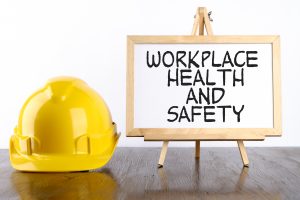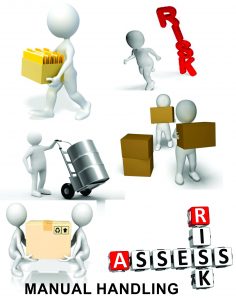 Sitting v standing — the risks
Sitting v standing — the risksThe health risks of sedentary work, for example, among office workers who sit in front of computers for the vast majority of their day, have been well documented in recent years.
Prolonged standing at work: the law
According to the HSE, while there is no specific legislation that relates to prolonged standing, the risk to employees’ health and safety from working in a standing position would fall under the general provisions of the Health and Safety at Work, etc Act 1974 and its associated regulations, e.g. the Management of Health and Safety at Work Regulations 1999 and the Workplace (Health, Safety and Welfare) Regulations 1992.
The HSE therefore advises that pragmatic controls that consider both seated and standing work are identified through an appropriate risk assessment.
Crucially, the HSE also emphasises the importance of involving and engaging the workforce in the risk assessment process, as staff can provide feedback on their workstation and practices that can lead to pragmatic and sensible adjustments.
Job design is a critical factor in protecting the health of staff who need to stand during their working day. The basic principles of good job design for standing work are as follows.
Specific points to consider could, depending on the type of work, relate to the following:
The HSE’s current Go Home Healthy campaign is targeting the musculoskeletal health of workers as one of its three key focuses, along with work-related lung diseases and stress.
Employers should be aware that static and fixed postures from prolonged standing can cause musculoskeletal disorders (MSDs), along with a range of other health issues.
In the context of the campaign and work involving prolonged standing, an HSE source warned against the pitfalls of starting with appropriate footwear or anti-fatigue matting. Rather, employers are encouraged to:
Certainly, thereafter, appropriate footwear and matting could also contribute to the overall risk reduction of the work.
Again, employers should rather be moving up the hierarchy of controls to think about the design of the work activity, rather than relying on training alone and the HSE has published advice for employers on how to get the right type of help in this regard.
An HSE source had the following to say about avoiding MSDs for staff who need to spend time working in a standing position:
“Fixed and static postures at work such as prolonged standing can affect workers’ health, making it more likely they will experience leg and lower back pain. It’s important that employers work with their employees to consider pragmatic solutions to reduce the risk of musculoskeletal problems — such as balancing sedentary and active work, rotating jobs, and providing rest breaks, appropriate workstations, and suitable equipment — to help ensure that workers can go home healthy.”
If you require advice, please contact us, Walker Health and Safety Services Limited.

It is a legal requirement for businesses where staff work at fixed workstations, home workers or hot-desking to complete the following:
Improper use of DSE or poorly designed workstations or environments can lead to staff suffering with neck, shoulder, and back pain as well as fatigue and eye strain.
What is a DSE risk assessment?
Most employers are required to carry out a DSE assessment, but what exactly is one, and what does it need to cover? To start, let’s understand what DSE is, then look at how we can assess it.
What is DSE?
DSE stands for Display Screen Equipment. As the name suggests, a DSE assessment is an assessment of Display Screen Equipment. Display Screen Equipment (DSE) is a device or equipment with a display screen and often refers to a computer screen. However, it includes both conventional display screens and those used in emerging technologies such as laptops, touchscreens and other similar devices.
In a work environment, desktop computers are traditionally looked at when considering DSE, but it is important to consider other display screens such as tablets, laptops and smartphones.
What is a DSE assessment?
A DSE assessment is an assessment of risk from the way we use computers, laptops, tablets and other display screens at work. Each workstation should be assessed, and the risks reduced as low as is practical.
A DSE assessment looks at how a user works at their workstation. Like any risk assessments, the aim is to identify the hazards and assess the likelihood and severity of harm to those that may be affected. Then, reduce the risk by altering the workstation or providing tools to make it comfortable.
If you have sat at a computer screen for a long time, you may already be familiar with some of the hazards. Poor posture or lack of movement throughout the day can lead to back pain. Staring at the screen for long lengths of time can give you headaches.
But it’s not just computer screens that are causing issues. Slouching over your phone, tablet or handheld device for even a short length of time can give you neck and upper back pain.
Why do we need a DSE assessment?
The Health and Safety (Display Screen Equipment) Regulations. These regulations lay out some key requirements for employers surrounding the use of DSE, one of which is the need to carry out a suitable and sufficient assessment of workstations used in the workplace.
2.—(1) Every employer shall perform a suitable and sufficient analysis of those workstations which – (regardless of who has provided them) are used for the purposes of his undertaking by users; or have been provided by him and are used for the purposes of his undertaking by operators The Health and Safety (Display Screen Equipment) Regulations 1992
Any workstation used by your business, regardless of who provides it, should be assessed. So DSE requirements apply to co-working spaces, remote working, temporary workplaces and your own offices.
However, this should not just be considered a tick box exercise to comply with legal requirements. A DSE assessment can actually help combat ill-health and conditions, such as epilepsy and therefore improve health and productivity in the workforce.
DSE assessments can also help increase productivity. This is the result of employees being less tired, and more comfortable while sitting/standing at their workstation.
What does a DSE risk assessment cover?
Problems are often caused by the way we use our DSE. The display screen may not be the cause of back pain, but the way you sit at it could. Computer workstations or equipment can be associated with neck, shoulder, back or arm pain, as well as with fatigue and eyestrain.
So, it’s not just the display screen that needs to be assessed. Everything to do with the use of the equipment should be considered. Other items looked at in the assessment includes, the keyboard, the mouse, furniture and the environment.
The assessment should also encompass the general environment and includes lighting, reflections, glare, temperature, humidity and noise. All of these elements can impact how the equipment is used, and the risks to users.
The business benefits to DSE assessments
Display screen equipment are the most common tool used across all businesses, and can offer many benefits to a business including:
Improved health, wellbeing and morale for DSE users
Sustained production from reduced sick leave
Minimising the risk of compensation claims for upper limb disorders
Reduced administration costs
Encourages positive behaviour and adoption of DSE good practice.
Improved organisation safety
Contact us should you require a DSE Assessment.
The Walker Health and Safety blog is brought to you by the team at Walker Health and Safety Services Limited. You can contact us using the address or email address below or via the form on our main site.
e-Innovation Centre
University of Wolverhampton
Telford Campus
Priorslee
Telford
Shropshire
West Midlands
TF2 9FT
E-mail: info@walkersafety.co.uk
Telephone: 0845 834 0400
Fax: 0845 834 0401
Guest Blogging
If you feel that you could contribute to this blog then please feel free to send me a proposal of your guest blogging ideas and we can discuss these further info@walkersafety.co.uk . Please note any proposals must be of benefit to my readers from individuals with knowledge of their subject matter.
 The top management of any organisation should take ultimate responsibility for occupational health and safety (OHS). As part of this, there should be a process in place that enable management to review health and safety performance.
The top management of any organisation should take ultimate responsibility for occupational health and safety (OHS). As part of this, there should be a process in place that enable management to review health and safety performance.
Reviewing health and safety performance closes the loop in the process and will inform the organisation whether it is effectively controlling risks and if the management system remains fit for purpose.
Focusing on the key words, the various standards available note the review should check that the system is:
The Health and Safety Executive (HSE) takes a slightly more simplified approach and suggests that the purpose of the review is to establish whether the principles of strong and active leadership, worker involvement, and assessment and review have been embedded in the organisation.
Whatever the purpose, a management review, like other functions, will require thought and planning to achieve the necessary outcomes of the review process.
As the phrase suggests, management reviews must be led by top management and as such, the executive holding responsibility for health and safety should have the authority and remit to undertake the management review.
Key to the success of the management review process is ensuring the right inputs in terms of information and data. According to ISO 45001, this will be based around the elements of the management system and will include:
In addition, the HSE publication INDG417 suggests that a management review should examine whether:
Similarly, BS 18004 makes recommendations as to inputs into the management review process including any organisation-specific leading and lagging performance indicators. It also suggests the following be considered.
There will be outcomes from any management review process. Both ISO 45001 and BS 45002 state that the management review should draw a conclusion as to the continuing suitability and effectiveness of the occupational health and safety management system.
Outcomes should include decisions related to:
Changes required will clearly be organisation-specific and can address any element of the management system including changes to the H&S policy, revised objectives, increased need for competency, etc.
One of the key purposes of a cyclical management system is to take opportunities for continual improvement. This can be influenced not just by identified shortfalls in performance against benchmarked best practice, but also by identifying where new technologies, for example, can reduce risks that do not exceed excessive costs. Other improvements could relate to ensuring the system is fully aligned as an integral part of the business.
Any change or improvement may have resource implications and the management review should identify what these resource implications are. The process for managing change will depend on the types of outcomes from the review process.
The outcomes of the management review should be communicated and where necessary consulted on with relevant stakeholders both internal and external to the organisation.
However, it may be the case that the outcomes and recommendations may require top management review and approval prior to being released into the public domain and implemented. This will very much depend on the sensitivity of the outcomes and the organisation culture.
Adequate records also need to be kept that ensure the findings of the review process are available to relevant parties such as enforcing authorities, staff representatives, those undertaking future management reviews, insurers, etc.
BS 18004 recommends that the outputs should be “incorporated within performance reports for communication to their various stakeholders”. This could include annual reports to investors, corporate governance and social responsibility statements.
Finally, where the management review indicates areas of good performance or even performance beyond the objectives set, top management may wish to celebrate this and recognise/reward those responsible for good performance levels.
Contact Walker Health and Safety Services for further advice.
 The Health and Safety at Work Act, etc 1974 states that employers should provide “such information, instruction, training and supervision as is necessary to ensure, so far as is reasonably practicable, the health and safety at work of his employees”. The Management of Health and Safety at Work Regulations 1999 further require that employers provide employees with adequate health and safety training both on recruitment and when the risks to which they are exposed change, for example, where they move to a new role or when new work equipment is provided.
The Health and Safety at Work Act, etc 1974 states that employers should provide “such information, instruction, training and supervision as is necessary to ensure, so far as is reasonably practicable, the health and safety at work of his employees”. The Management of Health and Safety at Work Regulations 1999 further require that employers provide employees with adequate health and safety training both on recruitment and when the risks to which they are exposed change, for example, where they move to a new role or when new work equipment is provided.
The Management of Health and Safety at Work Regulations 1999 go on to state that training should be repeated periodically where appropriate, be adapted to take account of any new or different risks and take place during working hours. Other sets of regulations which require training of employees include the Health and Safety (Display Screen Equipment) Regulations 1992, the Health and Safety (First-Aid) Regulations 1981, the Provision and Use of Work Equipment Regulations 1998 and the Regulatory Reform (Fire Safety) Order 2005.
Organisations that have their health and safety management systems certified, for example to BS OHSAS 18001 or ISO 45001, are also required to conform to requirements concerning competence.
Unfortunately, when it comes to work-related training, there is no one-size-fits-all. Employers should consider who in their organisation needs training, what training should be provided, when, by whom, and when training should be repeated and refreshed. Consideration should also be paid to whether staff require formal qualifications for their role, such as facility managers, first aiders, or the maintenance teams responsible for legionella safety.
Ensure Employees follow Your Training: 5 Top Tips. Click here
Training – Contact Us for your training requirements or to discuss training solutions. Click here to look at our website training page.

Did you know that manual handling causes over a third of all workplace injuries? These include work-related musculoskeletal disorders (MSDs) such as pain and injuries to arms, legs and joints, and repetitive strain injuries of various sorts.
Manual handling covers a wide range of activities including: lifting, pushing, pulling, holding, restraining, throwing and carrying. It includes repetitive tasks such as packing, typing, assembling, cleaning and sorting, using hand-tools, operating machinery and equipment, and handling and restraining animals.
Manual handling injuries can have serious implications for the employer and the person who has been injured. They can occur almost anywhere in the workplace and heavy manual labour, awkward postures, repetitive movements of arms, legs and back or previous/existing injury can increase the risk.
Twisting, turning and bending of the back should be avoided. The risk of back injury increases during lifting, carrying, pushing and pulling of loads, if the load is: Too heavy There is no exact weight limit for manual handling.
When carrying out a manual handling task, keep the load close to the body for as long as possible while lifting. Keep the heaviest side of the load next to the body. If a close approach to the load is not possible, try to slide it towards the body before attempting to lift it. Avoid twisting the back or leaning sideways, especially while the back is bent.
If you have employees that carry out manual handling activities, it is good practice to ensure they are trained in carrying out the task. A manual handling course would be beneficial. It would cover the Manual Handling Operation Regulations 1992 and other relevant legislation.
In 2013 more working days were lost to musculoskeletal problems (back and neck pain) than any other cause!
To help prevent injury in the work place where possible it is best to avoid lifting BUT of course this is not always practical. Ensuring your employees understand the risk and put measures in place prior to moving an item is the first step to reducing the risk of accident.
If you require a course, contact us for details.
This health and safety at work summary of statistics for Great Britain for 2017 is quite interesting – http://www.hse.gov.uk/statistics/overall/hssh1617.pdf
Contact us if you require further information.